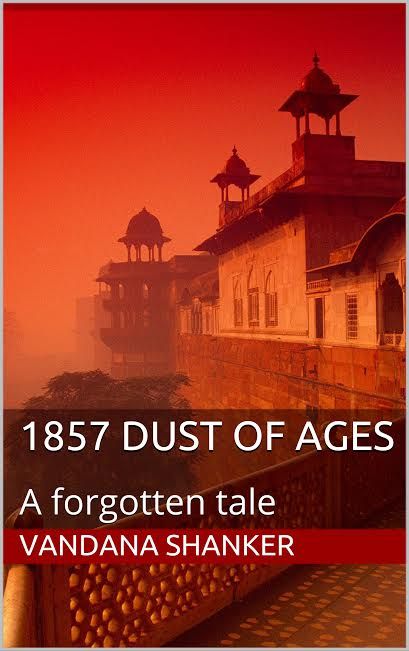Writing about the past, sitting in the present is a challenge, but its a mission well accomplished by the author. Read on to know more about this fascinating story, its author and what she has to say about this genre of historical fiction. . .
The greatest challenge is being true to the setting. Creating an atmosphere about which you have only read and therefore have a second-hand knowledge. Additionally, one needs to be careful of the way author’s twenty-first-century sensibilities impinge on the society and culture of the past, especially when creating the characters. I constantly asked myself ‘does the character seem too modern?’ ‘Is she/he true to the culture s/he comes from?’
Sanchita: An intriguing genre, a lovely tale and amazing reviews! That’s what 1857 Dust of Ages is all about. Tell us about how you unearthed this lovely story from the heaps of history? How did you get the idea and how did you go about researching it?
Vandana: Some years ago, while I was doing my research at IIT Delhi, a close friend was pursuing her research on 1857 narratives. As we talked and discussed our work, the interest developed. It brought back numerous stories, tales, Amar Chitra Kathas that I had read in my childhood about the war of 1857. We discovered that there are lots of British writers who have told the story of 1857 – in the nineteenth century as well as the twentieth century. However, the event is practically unexplored from the Indian perspective. There are no contemporary accounts of 1857 and very few fiction writers in India have explored the setting. The British work is interesting but of course, full of stereotypes. So we often talked about writing a counter-narrative. That is how the idea was born.
I read a lot of novels, British mostly, some diaries, letters, and non-fiction accounts. One of the contemporary writers whose work has left an impression is William Dalrymple. I often returned to White Mughals and The Last Mughal while writing Dust of Ages
Sanchita: Tell us about the challenges of writing in this genre of historical fiction?
Sanchita: Tell us about the challenges of writing in this genre of historical fiction?
Vandana: The greatest challenge is being true to the setting. Creating an atmosphere about which you have only read and therefore have a second-hand knowledge. Additionally, one needs to be careful of the way author’s twenty-first-century sensibilities impinge on the society and culture of the past, especially when creating the characters. I constantly asked myself ‘does the character seem too modern?’ ‘Is she/he true to the culture s/he comes from?’ And often the answer was an honest no. So one has to walk a tightrope between past and present.
Then, of course, the bane of historical fiction, it becomes too lengthy and the little tidbits of information add to the volume of the novel. Editing is a painful process.
Sanchita: Trace your interest in history. Share with us about how you got interested in this subject?
Sanchita: Trace your interest in history. Share with us about how you got interested in this subject?
Vandana: More than history, it is the historical fiction that I find fascinating. I believe that it is the best way to know history. Instead of dry numbers, statistics and dates, the stories leave an impact. They humanize history. There is also an aura of romance and nostalgia about bygone times. A good historical fiction always leaves one with bittersweet feelings. These are elements that I love.
Sanchita: The book cover is enticing, as if it tells a story by itself. What thought went behind it and as an author how important do you think is the book cover, given we tend to say, ‘Don’t judge a book by its cover’.
Vandana: In this case, I wanted to capture the aura of mystery, romance and of course, the very Indian-ness of the setting. I wanted to use some nineteenth-century painting initially, but had trouble finding one that suited the mood of the book. This picture, with its beautiful colour gradient, just fitted the story perfectly.
Despite the warning against judging the book by its cover, I feel that the cover is important. It is like that very important first impression – the first encounter that the reader has with a book. It is meant to capture the attention and at the same time, say something about the content of the book. So it is something every writer should put a lot of thought into.
Despite the warning against judging the book by its cover, I feel that the cover is important. It is like that very important first impression – the first encounter that the reader has with a book. It is meant to capture the attention and at the same time, say something about the content of the book. So it is something every writer should put a lot of thought into.
Sanchita: Sneak peek into your next project.
Vandana: I am currently working on a historical once again, set around 40 years after 1857, moving between Delhi and the Himalayas in the north. It is set against the backdrop of the Great Game. But it is in initial stages. Hopefully, I will have the first draft ready by the end of the year.
Rapid fire round (First thought that comes to mind on hearing these words)
a. Fort - Red
b. Rebel - Cause?
c. Red - Favourite color
d. Antique - History
e. History - Stories
About the Author
 |
| Author Vandana Shanker |
Delhi-born Vandana Shanker is the author of the series 1857 Dust of Ages, a historical fiction set in the year of the great uprising in India. A PhD from IIT Delhi, Vandana is passionate about history, storytelling and art. Apart from writing, she teaches literature and creative writing in Malaysia. She has also taught in Universities in India and Vietnam. She currently lives in Kuala Lumpur with her family and wants to travel the world.
Her book '1857 Dust of Ages' is available at:




0 Comments:
Post a Comment